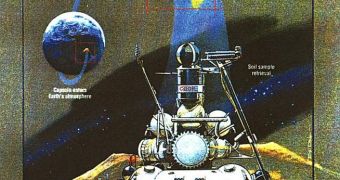The Cold War between the United States and the Soviet Union had many drawbacks, including the loss of significant scientific opportunities. Had the two countries cooperated, the Western world may have learned that water was first discovered on the Moon in 1976.
The precious chemical was identified in lunar soil samples brought back to Earth by the Luna-24 sample-return mission. The spacecraft landed on Earth's natural satellite back in August 1976, dug 2 meters underground, collected 300 grams of rocks, and then returned them here.
Soviet scientists immediately proceeded to study the samples, and found that 0.1 percent of the rocks' mass was accounted for by water. The research was detailed in a 1978 issue of the scientific journal Geokhimiia, and the paper was translated into English as well.
However, though available to anyone interested, the paper did not elicit any type of significant reaction from Western scientists, who were too busy ignoring the Communist Block, and had an utter contempt for any valuable research conducted behind the Iron Curtain.
Had they paid closer attention to what the Soviets were doing, they would have established that water is present on the Moon decades ago. But the Americans decided to focus their attention on the Apollo missions, preferring to send astronauts to Earth's natural satellite.
Though the samples brought back by the Apollo crews were initially thought to demonstrate that water exists on the Moon, subsequent analysis of the materials revealed that they were contaminated with water from our planet, due to faulty seals that had become clogged with lunar dust.
Decades later, when NASA finally returned to the Moon, the Clementine spacecraft was the first to detect indications that water is indeed present on the celestial body. It did this by analyzing radio waves its instruments bounced from the lunar surface.
Additional evidence was provided by the Lunar Prospector, the Indian spacecraft Chandrayaan-I orbiter, the Lunar Reconnaissance Orbiter (LRO) and the Lunar Crater Observation and Sensing Satellite (LCROSS) missions, Technology Review reports.
Following these investigation, which were undertaken over the past two decades, scientists in the West came to realize what their colleagues in the former Communist Block had known for about four decades – that significant amounts of water are available on the Moon, especially inside its permanently shadowed craters.
“As recently as 2006 the settled value for the lunar bulk water content was below 1 part per billion. Most values now discussed well exceed 1 part per million,” says Columbia University expert Arlin Crotts, who analyzed how many times the Soviet paper was cited.
“No other author has ever cited the Luna 24 work,” he concludes.

 14 DAY TRIAL //
14 DAY TRIAL //